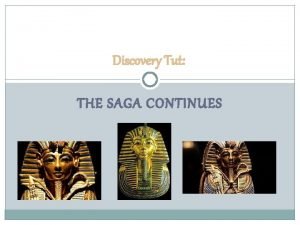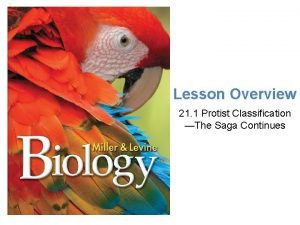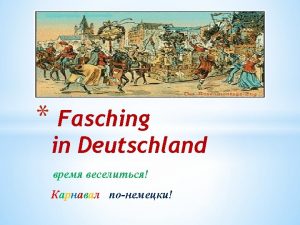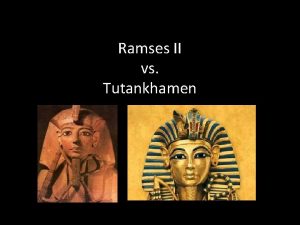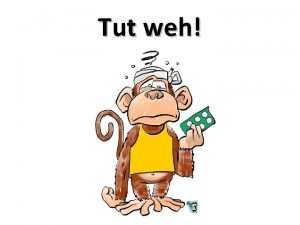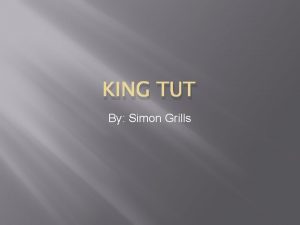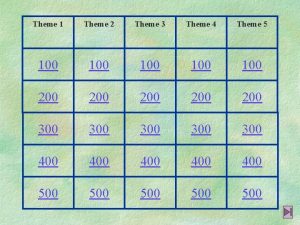DISCOVERING TUT THE SAGA CONTINUES Part1 MAIN THEME








- Slides: 8

DISCOVERING TUT : THE SAGA CONTINUES (Part-1)


MAIN THEME � � The lesson describes the historic archaeological event that took place on January 5. 2005. on this day, the remains of King Tut were brought out of the burial chamber at 6 pm for about three hours and a scan was carried out. Howard Carter had found the tomb in 1922 surprisingly intact. It contained splendid golden jewels and artifacts, and King Tut’s three gold coffins. King Tut was the last King of eighteenth dynasty and died young unexpectedly. His grand father Amenhotep III had ruled for about forty years. His reign was the golden period for the dynasty. Amenhotep IV, Tut’s father, changed the religion of the country. Tut restored the worship of Amun. King Tut’s mummy was the first one to be subjected to the CT scan. Earlier in 1922, Carter had the mummy cut into pieces in order to lift it from the coffin to which it had stuck due to hardened rasins. The CT scan pictures of the mummy showed clearly the vertebrae, head, hand, ribcage and other parts of the body.

KING TUT- The Last heir of Powerful Egyptian Empire He was just a teenager when he died. The last heir of a powerful family that had ruled Egypt and its empire for centuries, he was laid to rest laden with gold and eventually forgotten. Since the discovery of his tomb in 1922, the modern world has speculated about what happened to him, with murder being the most extreme possibility. Now, leaving his tomb for the first time in almost 80 years, Tut has undergone a CT scan that offers new clues about his life and death — and provides precise data for an accurate forensic reconstruction of the boyish pharaoh.

Day of CT Scan and the reaction of tourists An angry wind stirred up ghostly dust devils as King Tut was taken from his resting place in the ancient Egyptian cemetery known as the Valley of the Kings*. Dark-bellied clouds had scudded across the desert sky all day and now were veiling the stars in casket grey. It was 6 p. m. on 5 January 2005. The world’s most famous mummy glided head first into a CT scanner brought here to probe the lingering medical mysteries of this little understood young ruler who died more than 3, 300 years ago. All afternoon the usual line of tourists from around the world had descended into the cramped, rock-cut tomb some 26 feet underground to pay their respects. They gazed at the murals on the walls of the burial chamber and peered at Tut’s gilded face, the most striking feature of his mummy-shaped outer coffin lid. Some visitors read from guidebooks in a whisper. Others stood silently, perhaps pondering Tut’s untimely death in his late teens, or wondering with a shiver if the pharaoh’s curse — death or misfortune falling upon those who disturbed him — was really true.

KING TUT’S TOMB

The Funerary Treasure “The mummy is in very bad condition because of what Carter did in the 1920 s, ” said Zahi Hawass, Secretary General of Egypt’s Supreme Council of Antiquities, as he leaned over the body for a long first look. Carter—Howard Carter, that is — was the British archaeologist who in 1922 discovered Tut’s tomb after years of futile searching. Its contents, though hastily ransacked in antiquity, were surprisingly complete. They remain the richest royal collection ever found and have become part of the pharaoh’s legend. Stunning artefacts in gold, their eternal brilliance meant to guarantee resurrection, caused a sensation at the time of the discovery — and still get the most attention. But Tut was also buried with everyday things he’d want in the afterlife: board games, a bronze razor, linen undergarments, cases of food and wine. After months of carefully recording the pharaoh’s funerary treasures, Carter began investigating his three nested coffins. Opening the first, he found a shroud adorned with garlands of willow and olive leaves, wild celery, lotus petals, and cornflowers, the faded evidence of a burial in March or April. When he finally reached the mummy, though, he ran into trouble. The ritual resins had hardened, cementing Tut to the bottom of his solid gold coffin. “No amount of legitimate force could move them, ” Carter wrote later. “What was to be done? ”

HOME WORK 1. Who was Tut? Why was his demise a big event? 2. Who was Howard Carter? What was his discovery? 3. Why was King Tut’s mummy subjected to a CT scan? 4. What were the everyday things buried along with Tut’s mummy?
